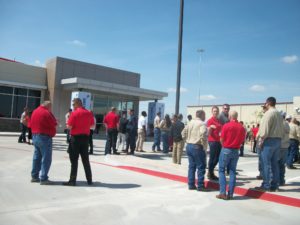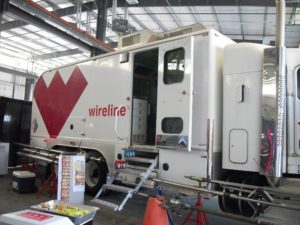“People said, ‘We’ve got to do something different.’”
The last downturn helped shift people’s mindsets. Weatherford’s latest project in Odessa shows what that change looks like.
By Paul Wiseman
“We’ve been in the Permian Basin for decades,” said Weatherford International’s Karen David-Green, “and this new facility allows us to consolidate 10 product lines under one roof. It also shows that we intend to always have a presence in the Permian Basin.” David-Green is  Weatherford’s senior VP of stakeholder engagement and its chief marketing officer.
Weatherford’s senior VP of stakeholder engagement and its chief marketing officer.
Out of 105 total acres at 710 S. Faudree Road, just south of I-20, 75 are currently developed with a network of buildings and open spaces. The facility is home to about 740 employees.
Expanding their product line over the decades through acquisitions, the company had amassed more than 50 separate locations in the Basin. The new facility will consolidate 21 of those locations, said David-Green. The ultimate goal is to get down to three in this area.
“Not only will this streamline our operation, with a single phone number and dispatch,” said David-Green, “it will create efficiencies in training, and will allow more cross-training, which is good for everyone.
“Plus,” she added, “with all our technicians in one place they can collaborate.”
Weatherford is looking to hire 80-100 people in jobs that include roles as crane operators, field technicians, engineers, human resources (HR), and accounting, among others, said Ellen Chin, Weatherford’s senior VP and chief human resources officer. Hiring so many people is no simple task, since every other business in the Permian is hiring, and many are seeking help in those same positions.
When asked how Weatherford can separate itself from the pack, Chin said, “When we hire someone, we want them to stay for their whole career. We present them challenges that can help them develop as a technician or into leadership.” With locations around the world, she noted, opportunities for promotions abound.
The company’s Western Hemisphere President, Mark Swift, acknowledged that one of the reasons for aggregating and cross-training is to mitigate the pain when downturns occur.
“If you want to get away from the boom-and-bust cycle, or minimize the disruption it brings to your business, you don’t want to go through training all these people and having them contribute, then having to let them go,” Swift said. Having everyone in one place means that when the activity in one product or service line is low, some people in that area can easily be moved to a busier line in the same building. “I don’t want to let people go—I want to give them a future and a career.”
 Currently the company brings in employees from other, less-busy locations. Some work on a rotating basis and others move here, but all receive a housing allowance to help with the boom-town cost of living, Swift said. Weatherford also keeps a number of man-camp rooms on permanent rentals so they’re available as needed.
Currently the company brings in employees from other, less-busy locations. Some work on a rotating basis and others move here, but all receive a housing allowance to help with the boom-town cost of living, Swift said. Weatherford also keeps a number of man-camp rooms on permanent rentals so they’re available as needed.
Addressing recent news involving the company’s bankruptcy filing, Swift was quick to say Weatherford sees the Permian as a long-term investment. “To me, [the Permian] is the center of the U.S. oil and gas universe, and it has been for almost 100 years. We’ve been here for a long time, we’re going to stay here through thick and thin. I think our investment here shows our commitment to the Basin.
“We’re going to build out some more to the north end where we’ve got some more land. We’ll build that out next year,” he added.
In discussing new technology Weatherford has developed, Swift said he’s seeing Permian producers becoming more open to upgrades, especially since the downturn of 2015-16. “The downturn helped shift people’s mindsets. So if there’s a silver lining to that last downturn, which was pretty brutal, it’s that people stepped back and said, ‘We’ve got to do something different.’”
Of particular pride for the company is its bucking unit, which they say is the largest in the region. It’s capable of makeup and breakup of joints in pipes ranging from 5-inch to 20-inch diameters. It handles clamp pressures of 0-1,300 psi and breakup pressures as high as 50,000 psi. Personnel noted that the unit and its operators—it just needs one person at any one time—is available 24/7.
Weatherford expects to host gatherings at the facility on at least an annual basis to showcase new equipment and technology.
Paul Wiseman is a freelance writer in Midland.









